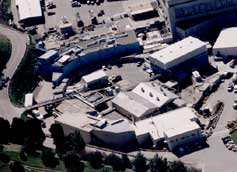

Thursday - January 4, 2007
SLAC Today is
available online at:
http://today.slac.stanford.edu
In this issue:
Botulism Study Could Lead to New Vaccines and Treatments to Counter Bioterrorist Attacks
Science Today: KIPAC: Batch Computing
New Issue of symmetry Released
 |
 |
|
Thursday - January 4, 2007 |
Botulism Study Could Lead to New Vaccines and Treatments to Counter Bioterrorist Attacks
X-ray crystallography studies completed at SSRL helped to produce the first three-dimensional, atomic-scale images of botulinum neurotoxin binding to its specific protein receptor on the surface of a neuron.
Of all the weapons in the bioterrorist arsenal, none is as potent as botulinum neurotoxin, which causes botulism—a potentially fatal disease with symptoms that include severe paralysis of the limbs and respiratory muscles. Just 1 gram of botulinum neurotoxin, evenly dispersed and inhaled, could kill more than a million people, according to a 2001 study in the Journal of the American Medical Association. Botulinum also holds the distinction of being the only high-risk biological weapon that's approved for therapeutic and cosmetic use as the active ingredient in the widely prescribed commercial products Botox and Dysport. Now, through studies conducted at the Stanford Synchrotron Radiation Laboratory (SSRL), scientists from Stanford and the Medical School of Hannover in Germany have figured out how this powerful neurotoxin binds to and disables individual nerve cells. Researchers say their discovery, published in the Dec. 13 online edition of the journal Nature, could lead to new treatments for botulism, which also is caused by eating botulinum-contaminated food. Read more... |
||
|
|
||
 Batch Cosmology
Traditional optical astronomy, built around "observing runs," takes the team to the mountain for a night or more of dedicated telescope time. Naturally, observing sites are remote and these trips are tough on research, teaching and personal schedules. With most projects granted a handful of nights per year and typical weather patterns lasting about as long as a run, small number statistics guarantee that many programs need several years' chances to achieve success. Some science programs also aren't amenable to block scheduling as a result of transient "targets of opportunity" or long-term survey and monitoring programs. Read more... |
New Issue of symmetry
You can read the magazine online, pick up a print copy at various locations around SLAC, or subscribe to the mailing list by filling out an online form. |
Events (see all | submit)
Access (see all)
Announcements
|
| | ||
|
|
||
 <%
Response.AddHeader "Last-modified", getArticleDate()
'Response.AddHeader "Last-modified","Mon, 01 Sep 1997 01:03:33 GMT"
'Monday, December 06, 2010
%>
<%
Response.AddHeader "Last-modified", getArticleDate()
'Response.AddHeader "Last-modified","Mon, 01 Sep 1997 01:03:33 GMT"
'Monday, December 06, 2010
%>View online at http://today.slac.stanford.edu/. |
||